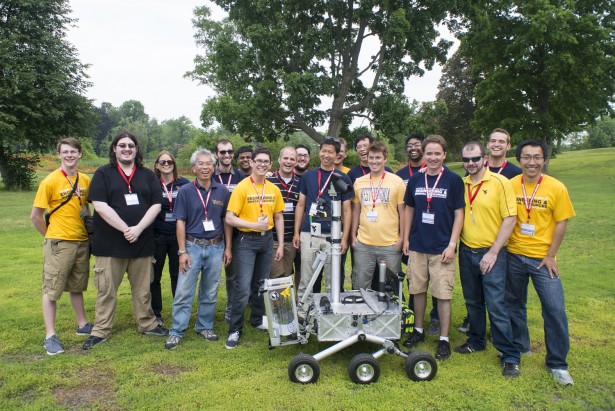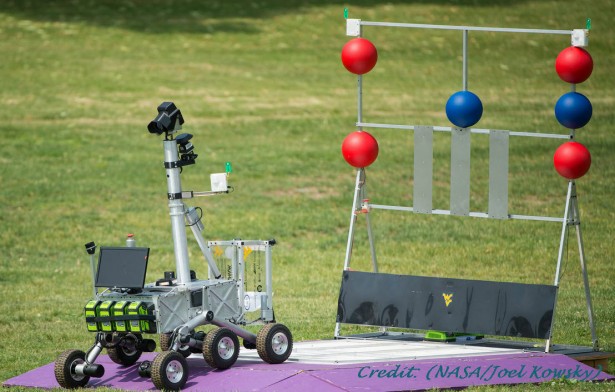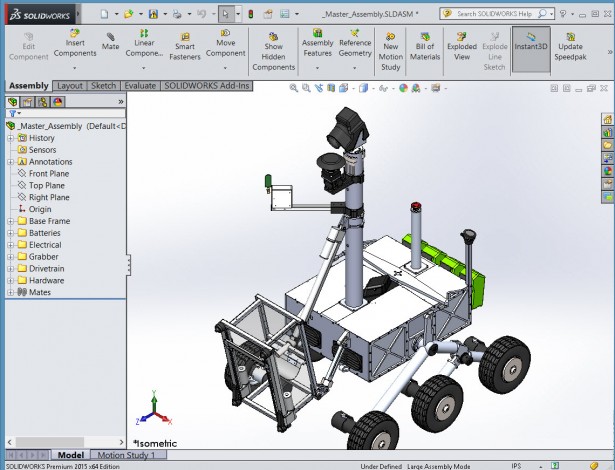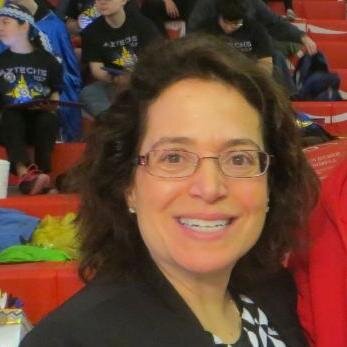West Virginia University wins NASA Robot Competition

NASA Sample Return Robot Challenge encourages innovation in autonomous robotics as teams locate and collect samples across a wide variety of terrain and obstacles without human intervention. The Cataglyphis Mountaineers robotics team from West Virginia University (WVU) college of engineering, under the direction of Dr Yu Gu, rose to the challenge, worked together, and last week won the $100,000 NASA prize. Sixteen teams competed at the NASA event held at WPI. The competition looks to improve NASA’s capability to explore a variety of destinations in space and to enhance the development in US robotic technology for use in industries and our planet. (Photo credits: NASA/Joel Kowsky)
I was fortunate to interview Lisa Kogan and Alex Hypes, about the Cataglyphis WVU robotics team, winning the NASA event, and their use of SOLIDWORKS. Here is their story.
Cataglyphis WVU robotics team is made up of a undergraduates and graduate students. Students are studying Mechanical Engineering, Computer Science, Electrical Engineering and Industrial Engineering. Three of the faculty mentors are from the Mechanical and Aerospace Engineering Department, and the fourth is from the Lane Department of Computer Science and Electrical Engineering.
The SOLIDWORKS Edu team has seen WVU students compete before. WVU has a strong student team culture, and many of the members previously worked on competitions such as SAE Baja, Design-Build-Fly, and the Robotic Mining Competition. A few of the WVU team members even started out competing in the FIRST Robotics (FRC), high-school robotics competitions and sought out robotics teams when they enrolled at WVU.

Marie: Describe “NASA Sample Return Robot” what type of robot is it?
Lisa and Alex: The WVU NASA Sample Return Robot is rover that must autonomously search a pre-defined area to find, acquire, and return samples of interest to the starting platform. Our robot, Cataglyphis, is named after a desert ant that exhibits special navigational ability that enable it to travel for hours and still accurately return home when it is finished. We incorporated similar behaviours in our robot, and added processing of visual information from a camera for sample detection, LIDAR information from a 2D laser scanner for obstacle avoidance, and a robust collection system for retrieving samples. The chassis of the robot is driven and supported by a rocker-boagie system similar to those used by rovers on Mars.

Marie: Why did you enter the NASA Sample Return Robot competition?
Lisa and Alex: The NASA Sample Return Robot Challenge is an excellent test of engineering and teamwork, and a great platform for students to learn about a variety of fields. The high difficulty of the Sample Return Robot Challenge requires students to work together as a team to ensure that all components of the challenge are adequately addressed in a robust manner. When there is only one attempt at the competition, reliability is paramount.
Marie: What were the biggest challenges for the WVU NASA Sample Return Robot?
Lisa and Alex:The biggest challenges for the WVU NASA Sample Return Robot were establishing robust systems for navigation, sample detection, and sample retrieval.
Marie: How did SOLIDWORKS help WVU robot team with these challenges?
Lisa and Alex:SOLIDWORKS enabled the WVU SRRC team to build an effective mechanical platform. Using SOLIDWORKS with a 3D printer also enabled us to rapidly prototype components and allowed the programming, navigation, and vision teams to quickly test new concepts. We also used SOLIDWORKS to develop custom guards to shield important electrical components from rain. When components were mature, we sent out components for machining as SOLIDWORKS parts within assemblies, and also used SOLIDWORKS to create engineering drawings for machining parts in house.
Marie:Does the WVU robot team learn SOLIDWORKS in school?

Lisa and Alex:Yes, SOLIDWORKS is the primary CAD program for the mechanical and aerospace engineering program at WVU.
Marie: Did you use SOLIDWORKS Simulation, Flow Simulation Motion, SOLIDWORKS Electrical or any other SOLIDWORKS software application?

Lisa and Alex:We used SOLIDWORKS Simulation for the rims and smaller parts for quick validation. We also used SOLIDWORKS to plan out the 4-bar linkage that comprised the grabber raise and lower mechanism to fit the desired grabber location when fully extended and fully raised.

Marie: If you wanted to tell the world something special about your robot, what would you say?
Lisa and Alex:The robot our team developed performed exactly as planned during the competition. The development of special navigation techniques enabled our robot to traverse the field up to 150 m away from the starting platform without being lost, and then return to the starting platform to perform a high precision drop-off of the samples Cataglyphis found and retrieved. Our robot uses a combination of ultra-wide band ranging radio information, wheel encoder odometry, lidar point-clouds, inertial measurement information, and visual processing techniques to accurately estimate its position in space, and locate the position of samples and the starting platform.
Thank you Cataglyphis Mountaineers robotics team for sharing with the SOLIDWORKS Community.
On a side note, last week SOLIDWORKS EDU featured FRC Team MARS from West Virginia as we started our SOLIDWORKS FIRST Mentor program. Great engineering talent from Mountaineers of all ages! Marie




